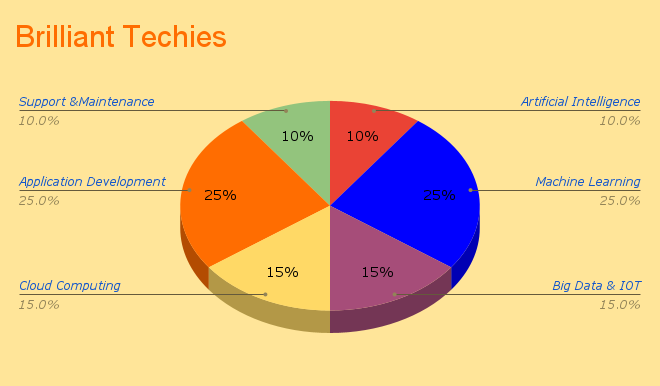Portfolio
- Home
- Portfolio
When we talk about our portfolio implementation here are our goals and we wanted to make sure our team balances all the areas which we wanted to focus on.
This will help us grow and serve the customers better in all kinds of areas. The following are the different types of port folios we are concentrating majorly.
- Application Development
- Cloud Computing
- Machine Learning
- Artificial Intelligence
- Big Data & IOT
- Support & Maintenance

The following Pie chart depicts Our targeted Percentage which we are aiming for in terms of different technologies.
Choosing the right platform and technology makes us perform better in the industry and our main focus is to balance rightly on the expenditure of Resources and the training.
The following are the some of the standards as an organization we wanted to focus on and help the customers to get all the details along with the software delivery which includes as below.
Clean Code:
We wanted to make sure our developers always focus on code Quality, and this is one of the criteria which makes difference between the developer vs good developer and when code runs in production with Quality performs better in handling anyunanticipated scenarios. Good code is simple, consistent, and easy to read, it implements the best practices, and most importantly, it is easy to test and maintain.
Documentation:
Documentation helps keep track of all aspects of the software development process and it improves the quality of a software outcome. Successful documentation will make for easily accessible information, help new users to onboard quickly, lower support and maintenance costs.
In software development, we wanted to make sure we document different aspects of the development process – from business requirements, business specification, technical specification, code, test scenarios to user manuals.
Agile:
Agile is one of the most important principles in software development. the iterative development help companies to deliver value to customer faster, where requirements and solutions evolve through collaboration between self-organizing and cross-functional teams.
The most popular Agile methodologies are Scrum and Kanban. Agile leads to better software quality, customer satisfaction, better control in the development process, improved project predictability, reduced risks, increased flexibility, and improved team morale.
DevOps:
Under DevOps, development and operations are no longer two separate silos. They are merged into one single team where each individual works across the entire application lifecycle. The primary goal of DevOps is to automate almost everything.
the benefits of DevOps are speed, increased frequency and pace of releases, quality of application updates and infrastructure changes, scalability, and improved collaboration between teams.
Quality Assurance:
The goal of Quality Assurance is detecting issues and preventing failures or ensuring proper quality of the final software outcome compatible with business requirements and expectations.
Quality assurance is focused on assuring the quality of a piece of software and it is in line with the customer’s requirements. Quality assurance ensures that the team follows procedures of the software development lifecycle. The main benefits of a good quality assurance process are improved software development efficiency, boosted customer satisfaction, and increased credibility.